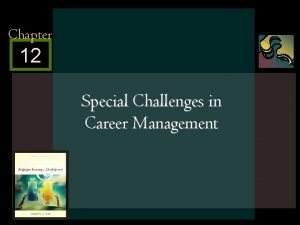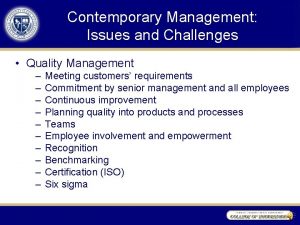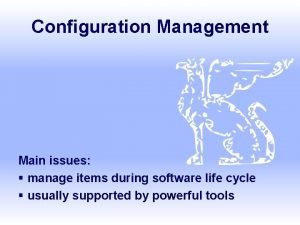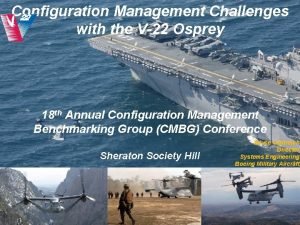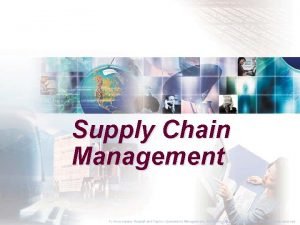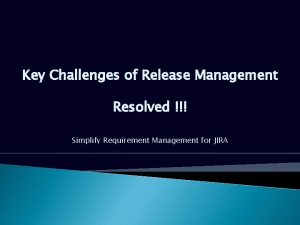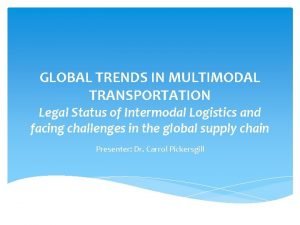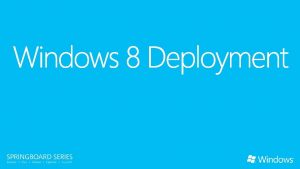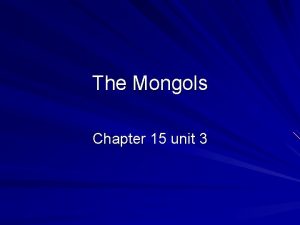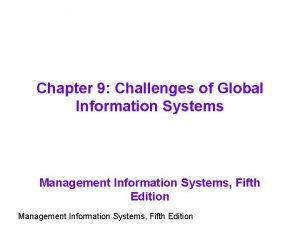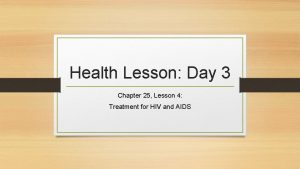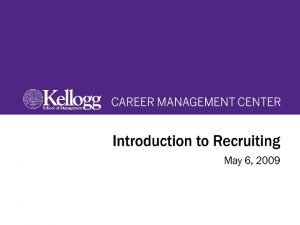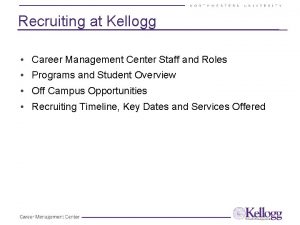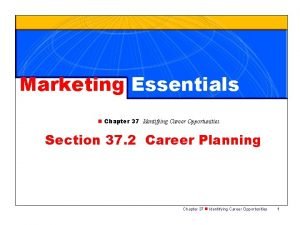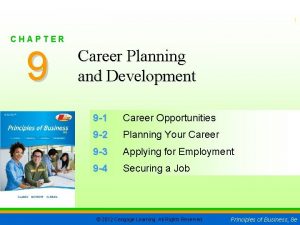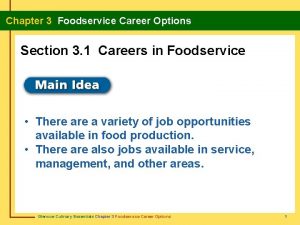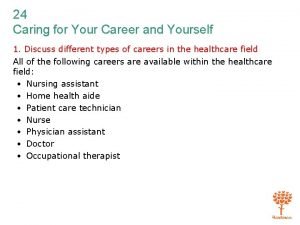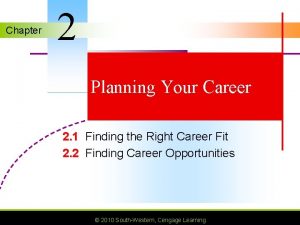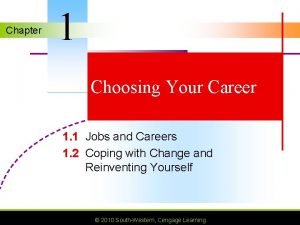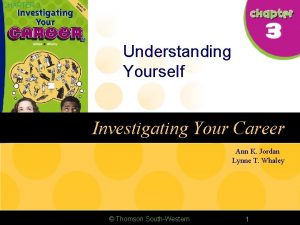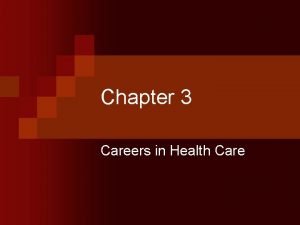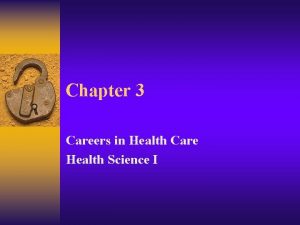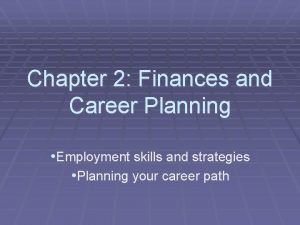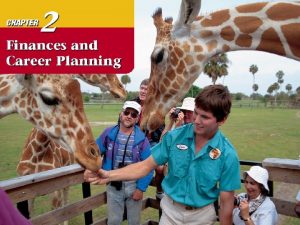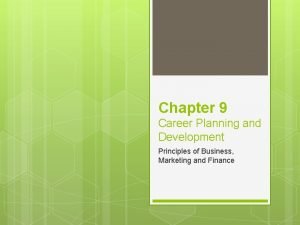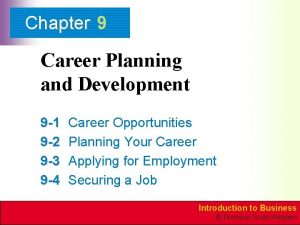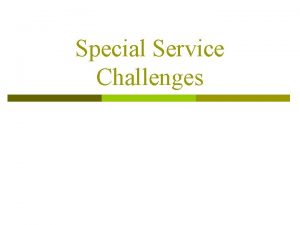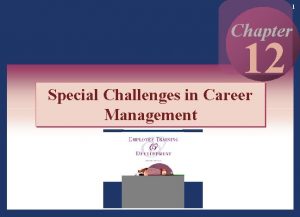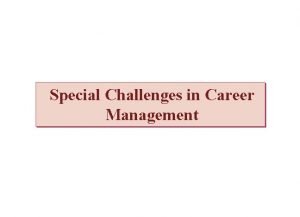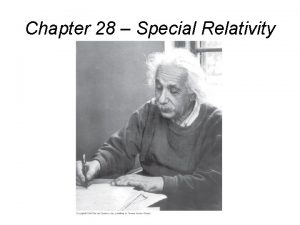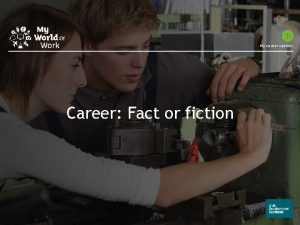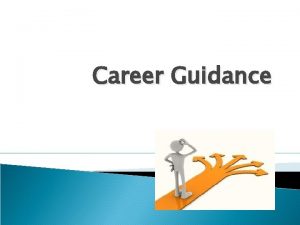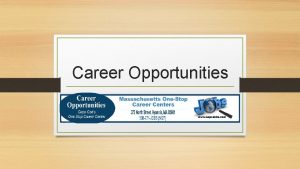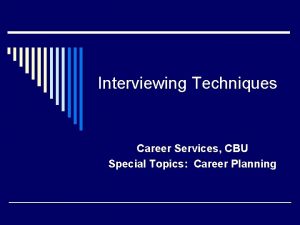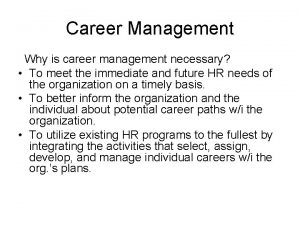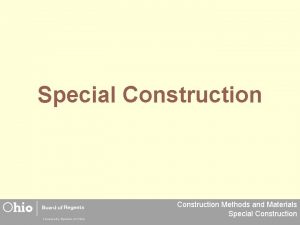Chapter 12 Special Challenges in Career Management Mc









































- Slides: 41

Chapter 12 Special Challenges in Career Management Mc. Graw-Hill/Irwin © 2005 The Mc. Graw-Hill Companies, Inc. All rights reserved. 12 - 1

Introduction Supportive work-life culture – a company culture that: acknowledges and respects family and life responsibilities and obligations encourages managers and employees to work together to meet personal and work needs Helping employees balance work and life, benefits the business and employees’ personal lives Mc. Graw-Hill/Irwin © 2005 The Mc. Graw-Hill Companies, Inc. All rights reserved. 12 - 2

Work-Life Balance Employee’s Perspective Employer’s Perspective Trying to manage work obligations as well as family and life responsibilities The challenge of creating a supportive company culture where employees can focus on their jobs while at work Mc. Graw-Hill/Irwin © 2005 The Mc. Graw-Hill Companies, Inc. All rights reserved. 12 - 3

If companies do not help their employees with their personal lives, they may leave for jobs with other companies in other areas that do. Mc. Graw-Hill/Irwin © 2005 The Mc. Graw-Hill Companies, Inc. All rights reserved. 12 - 4

Special Challenges in Career Management Socialization and Orientation Dealing With Older Workers Dual-Career Paths Coping With Job Loss Plateauing Balancing Work and Life Work and Non-work Policies Mc. Graw-Hill/Irwin Skills Obsolescence © 2005 The Mc. Graw-Hill Companies, Inc. All rights reserved. 12 - 5

Socialization and Orientation Organizational socialization - the process by which new employees are transformed into effective members of the company The purpose of orientation is to: Prepare employees to perform their jobs effectively Learn about the organization Establish work relationships Mc. Graw-Hill/Irwin © 2005 The Mc. Graw-Hill Companies, Inc. All rights reserved. 12 - 6

Phases of the Socialization Process Anticipatory Socialization Encounter Settling In Mc. Graw-Hill/Irwin © 2005 The Mc. Graw-Hill Companies, Inc. All rights reserved. 12 - 7

What Employees Should Learn and Develop Through Socialization: History Company Goals Politics Mc. Graw-Hill/Irwin Language People Performance Proficiency © 2005 The Mc. Graw-Hill Companies, Inc. All rights reserved. 12 - 8

Socialization and Orientation Programs Play an important role in socializing employees Effective socialization programs result in employees having a strong commitment and loyalty to the company This reduces turnover Effective orientation programs include active involvement of the new employee Effective programs have peers, managers, and senior co-workers actively involved Mc. Graw-Hill/Irwin © 2005 The Mc. Graw-Hill Companies, Inc. All rights reserved. 12 - 9

Content of Orientation Programs Company-Level Information Department-Level Information Company overview Department functions Key policies and procedures Job duties & responsibilities Compensation Policies, procedures, rules Employee benefits & services Performance expectations Safety & accident protection Tour of department Employee & union relations Introduction to co-workers Physical facilities Miscellaneous Economic factors Community Customer relations Housing Family adjustment Mc. Graw-Hill/Irwin © 2005 The Mc. Graw-Hill Companies, Inc. All rights reserved. 12 - 10

Characteristics of Effective Orientation Programs Employees are encouraged to ask questions Program includes information on both technical and social aspects of the job Orientation is the responsibility of the new employee’s manager New employees are not debased or embarrassed Formal and informal interactions with managers and peers occur Programs involve relocation assistance Employees receive information about the company’s products, services, and customers Mc. Graw-Hill/Irwin © 2005 The Mc. Graw-Hill Companies, Inc. All rights reserved. 12 - 11

Dual-Career Paths A career path is a sequence of job positions involving similar types of work and skills that employees move through in the company For companies with professional employees, a key issue is how to ensure that they feel they are valued The traditional career path model has limited advancement opportunities for those in the technical career path Mc. Graw-Hill/Irwin © 2005 The Mc. Graw-Hill Companies, Inc. All rights reserved. 12 - 12

Traditional career path for scientists and managers: Director Assistant Director Department Manager Principal Research Scientist Manager Assistant Manager Scientist Individual Contributor Career Path Mc. Graw-Hill/Irwin Management Career Path © 2005 The Mc. Graw-Hill Companies, Inc. All rights reserved. 12 - 13

A dual-career-path system enables employees to remain in a technical career path or move into a management career path. Mc. Graw-Hill/Irwin © 2005 The Mc. Graw-Hill Companies, Inc. All rights reserved. 12 - 14

Director Example of Dual. Career-Path System Fellow Department Manager Senior Research Leader Section Manager Senior Program Manager Research Leader Associate Section Manager Program Manager Senior Research Scientist Principal Research Scientist Project Manager Research Scientist Researcher Mc. Graw-Hill/Irwin © 2005 The Mc. Graw-Hill Companies, Inc. All rights reserved. 12 - 15

Characteristics of Effective Career Paths (1 of 2) Salary, status, and incentives for technical employees compare favorably with those of managers Individual contributors’ base salary may be lower than managers’, but they are given opportunities to increase their total compensation through bonuses The individual contributor career path is not used to satisfy poor performers who have no managerial potential Mc. Graw-Hill/Irwin © 2005 The Mc. Graw-Hill Companies, Inc. All rights reserved. 12 - 16

Characteristics of Effective Career Paths (2 of 2) The career path is for employees with outstanding technical skills Individual contributors are given the opportunity to choose their career path The company provides assessment resources Assessment information enables employees to make comparisons between their interests and abilities with those of employees in technical and managerial positions Mc. Graw-Hill/Irwin © 2005 The Mc. Graw-Hill Companies, Inc. All rights reserved. 12 - 17

Plateauing means that the likelihood of the employee receiving future job assignments with increased responsibility is low Mid-career employees are most likely to plateau Plateauing becomes dysfunctional when the employee feels stuck in a job that offers no potential for personal growth Such frustration results in poor job attitude, increased absenteeism, and poor job performance Mc. Graw-Hill/Irwin © 2005 The Mc. Graw-Hill Companies, Inc. All rights reserved. 12 - 18

Reasons Employees Can Plateau Discrimination based on age, gender, or race Lack of ability Lack of training Low need for achievement Unfair pay decisions or dissatisfaction with pay raises Confusion about job responsibilities Slow company growth resulting in reduced development opportunities Mc. Graw-Hill/Irwin © 2005 The Mc. Graw-Hill Companies, Inc. All rights reserved. 12 - 19

Possible Remedies for Plateaued Employees Employee understands the reasons for plateauing Employee is encouraged to participate in development activities Employee is encouraged to seek career counseling Employee does a reality check on his or her solutions Mc. Graw-Hill/Irwin © 2005 The Mc. Graw-Hill Companies, Inc. All rights reserved. 12 - 20

Skills Obsolescence – a reduction in an employee’s competence resulting from a lack of knowledge of new work processes, techniques, and technologies that have developed since the employee completed her education Not just a concern of technical and professional occupations all employees are at risk Obsolescence needs to be avoided if companies are trying to become learning organizations Mc. Graw-Hill/Irwin © 2005 The Mc. Graw-Hill Companies, Inc. All rights reserved. 12 - 21

Factors Related to Updating Skills Company Climate Manager • Provide Challenging Work Assignments • Emphasis on Continuous Learning • Encourage Employees to Acquire New Skills Updated Skills Peers Reward System • Discuss Ideas • Sabbaticals • Share Information • Pay for New Ideas • Pay for Employee Development Mc. Graw-Hill/Irwin © 2005 The Mc. Graw-Hill Companies, Inc. All rights reserved. 12 - 22

Additional Steps to Avoid Obsolescence (1 of 2) 1. Provide employees with the opportunity to exchange information and ideas 2. Give employees challenging job assignments early in their careers 3. Provide job assignments that challenge employees and require them to “stretch” their skills 4. Provide rewards for updating behaviors, suggestions, and innovations Mc. Graw-Hill/Irwin © 2005 The Mc. Graw-Hill Companies, Inc. All rights reserved. 12 - 23

Additional Steps to Avoid Obsolescence (2 of 2) 5. Allow employees to: q q q attend professional conferences subscribe to professional journals and magazines enroll in university, technical school, or community college courses at low or no cost 6. Encourage employees to interact in person or electronically to discuss problems and new ideas Mc. Graw-Hill/Irwin © 2005 The Mc. Graw-Hill Companies, Inc. All rights reserved. 12 - 24

Balancing Work and Life (1 of 2) Families with a working husband, homemaker wife, and two or more children account for only 7 percent of American families The increasing number of two-career couples and single heads of households creates a challenge for companies Companies have to carefully consider how to manage employees who are simultaneously meeting the needs of both work and family Mc. Graw-Hill/Irwin © 2005 The Mc. Graw-Hill Companies, Inc. All rights reserved. 12 - 25

Balancing Work and Life (2 of 2) Family and Medical Leave Act (FMLA) There are two roles that training can play in balancing work and non-work: trainers and managers may be responsible for developing policies and procedures trainers may be responsible for developing training programs to teach managers their role in administering and overseeing the use of work-life policies Mc. Graw-Hill/Irwin © 2005 The Mc. Graw-Hill Companies, Inc. All rights reserved. 12 - 26

Types of Work-Life Conflict Time-Based Conflict Strain-Based Conflict Behavior-Based Conflict Mc. Graw-Hill/Irwin © 2005 The Mc. Graw-Hill Companies, Inc. All rights reserved. 12 - 27

Company Policies to Accommodate Work and Non-work: Identifying work and life needs and communicating information about work and non-work policies and job demands Flexibility in work arrangements and work Schedules Redesigning jobs Managerial support for work-life policies Dependent care support: child and elder care Mc. Graw-Hill/Irwin © 2005 The Mc. Graw-Hill Companies, Inc. All rights reserved. 12 - 28

Example of work-life programs at Bank of America: Child Care Plus Adoption Reimbursement Tuition Reimbursement Flexible Work Arrangements Time Off and Leaves Employee Assistance Program Life. Works© Mc. Graw-Hill/Irwin © 2005 The Mc. Graw-Hill Companies, Inc. All rights reserved. 12 - 29

Examples of Alternative Work Schedules and Work Arrangements Traditional Flextime Compressed Workweek Temporary Work Job Sharing Mc. Graw-Hill/Irwin Part-Time Work Shift Work Telecommuting Reduced Work Hours Hoteling © 2005 The Mc. Graw-Hill Companies, Inc. All rights reserved. 12 - 30

For Job Sharing to be Effective: (1 of 2) 1. The impact of job sharing on clients and customers must be determined 2. The employee interested in job sharing must find another employee performing the same job who wants reduced work hours 3. The two people sharing the job need to have similar work values and motivations Mc. Graw-Hill/Irwin © 2005 The Mc. Graw-Hill Companies, Inc. All rights reserved. 12 - 31

For Job Sharing to be Effective: (2 of 2) 4. The manager must actively communicate with the job-sharing employees and accept the fact that they might not be immediately available for consultation 5. Meeting schedules, work assignments, and vacation schedules need to be carefully coordinated 6. Performance evaluation of job sharers needs to include both an individual and team appraisal Mc. Graw-Hill/Irwin © 2005 The Mc. Graw-Hill Companies, Inc. All rights reserved. 12 - 32

Recommendations for the Development of Dependent Care Assistance Programs: 1. Use surveys and focus groups to determine need 2. Develop a philosophy or rationale related to business objectives 3. Solicit employees’ participation in designing and implementing the program 4. Allocate resources for communicating the program to employees and managers 5. Request feedback from users to make adjustments to the program Mc. Graw-Hill/Irwin © 2005 The Mc. Graw-Hill Companies, Inc. All rights reserved. 12 - 33

Coping With Job Loss (1 of 2) Important career management issue because of the increased use of downsizing to deal with excess employees resulting from corporate restructuring, mergers, acquisitions, and takeovers Companies that lay off employees can experience lowered job commitment, distrust of management, and difficulties recruiting new employees Job loss causes stress and disrupts the personal lives of laid-off employees Mc. Graw-Hill/Irwin © 2005 The Mc. Graw-Hill Companies, Inc. All rights reserved. 12 - 34

Coping With Job Loss (2 of 2) From a career management standpoint, companies and managers have two major responsibilities: They are responsible for helping employees who will lose their jobs Steps must be taken to ensure that the “survivors” of the layoff (remaining employees) remain productive and committed to the organization Mc. Graw-Hill/Irwin © 2005 The Mc. Graw-Hill Companies, Inc. All rights reserved. 12 - 35

Outplacement services should include: Advance warning and explanation for a layoff Psychological, financial, and career counseling Assessment of skills and interests Job campaign services (e. g. , résumé-writing assistance) Job banks Electronic delivery of job openings, self-directed career management guides, and values and interest inventories Mc. Graw-Hill/Irwin © 2005 The Mc. Graw-Hill Companies, Inc. All rights reserved. 12 - 36

Dealing With Older Workers Age Discrimination in Employment Act Meeting the needs of older workers Pre-retirement socialization Retirement Early retirement programs Mc. Graw-Hill/Irwin © 2005 The Mc. Graw-Hill Companies, Inc. All rights reserved. 12 - 37

Meeting the Needs of Older Workers (1 of 2) Flexibility in scheduling to allow for care of sick spouses, return to school, travel, or reduced work hours Older workers should receive the training they need to avoid skill obsolescence and to be prepared to use new technology Older employees need resources and referral help that addresses long-term care and elder care Mc. Graw-Hill/Irwin © 2005 The Mc. Graw-Hill Companies, Inc. All rights reserved. 12 - 38

Meeting the Needs of Older Workers (2 of 2) Assessment and counseling to help older workers recycle to new jobs or careers, or Transition to less secure positions whose responsibilities are not as clearly outlined Companies need to ensure that employees do not hold inappropriate stereotypes about older employees Mc. Graw-Hill/Irwin © 2005 The Mc. Graw-Hill Companies, Inc. All rights reserved. 12 - 39

Preretirement Socialization Programs Typically address the following topics: Psychological aspects of retirement Housing (i. e. , transportation, costs, proximity to medical care) Health during retirement Financial planning, insurance, and investments Health care plans Estate planning The collection of benefits from company plans and Social Security Mc. Graw-Hill/Irwin © 2005 The Mc. Graw-Hill Companies, Inc. All rights reserved. 12 - 40

Early Retirement Programs To avoid costly litigation, companies need to make sure that their early retirement programs contain the following features: The program is part of the employee benefit plan The company can justify age-related distinctions for eligibility for early retirement Employees are allowed to voluntarily choose early retirement Mc. Graw-Hill/Irwin © 2005 The Mc. Graw-Hill Companies, Inc. All rights reserved. 12 - 41
 Dual career path example
Dual career path example Patients with special challenges
Patients with special challenges Fcs lanchpad
Fcs lanchpad Formulas for career success: résumés - assessment
Formulas for career success: résumés - assessment Chapter 6 career readiness
Chapter 6 career readiness Contemporary management issues
Contemporary management issues Configuration management challenges
Configuration management challenges Bruce oestreich
Bruce oestreich Global supply chain management challenges
Global supply chain management challenges Release management challenges
Release management challenges Global supply chain management challenges
Global supply chain management challenges Configuration management challenges
Configuration management challenges Toward civil war lesson 3 secession and war
Toward civil war lesson 3 secession and war Chapter 38 challenges to the postwar order
Chapter 38 challenges to the postwar order The federalist era lesson 2 early challenges
The federalist era lesson 2 early challenges Chapter 15 the last great nomadic challenges
Chapter 15 the last great nomadic challenges Challenges of global information systems
Challenges of global information systems The americans chapter 15
The americans chapter 15 Chapter 25 lesson 1 health
Chapter 25 lesson 1 health Kellogg cmc
Kellogg cmc Kellogg career management system
Kellogg career management system Festival and special event management
Festival and special event management Special event marketing plan
Special event marketing plan Festival and special event management
Festival and special event management Chapter 37 identifying career opportunities
Chapter 37 identifying career opportunities Chapter 9 career planning and development
Chapter 9 career planning and development Chapter 3 foodservice career options
Chapter 3 foodservice career options Chapter 31 caring for your career and yourself
Chapter 31 caring for your career and yourself Chapter 2 planning your career
Chapter 2 planning your career Chapter 1 choosing your career
Chapter 1 choosing your career Chapter 24 caring for your career and yourself
Chapter 24 caring for your career and yourself Chapter 3 career in health care
Chapter 3 career in health care Chapter 3 careers in healthcare
Chapter 3 careers in healthcare Chapter 2 finances and career planning
Chapter 2 finances and career planning Chapter 4 finances and career planning
Chapter 4 finances and career planning Chapter 2 career skills in health informatics
Chapter 2 career skills in health informatics Personal finance unit 1
Personal finance unit 1 Chapter 9 career planning and development
Chapter 9 career planning and development Chapter 9 career planning and development
Chapter 9 career planning and development Top management and middle management
Top management and middle management Management pyramid
Management pyramid Top level management
Top level management
